AVL 树
AVL 树
当要构造二叉树的原有元素序列接近有序时,构造的二叉树会退化成一棵单支树,此二叉树的查找效率也接近于 O(n),这就失去了构造二叉树的意义(如图1)。为了解决这一问题,苏联科学家 Adelson-Velskii 和 Landis 发明了一种自平衡二叉树,即 AVL 树。
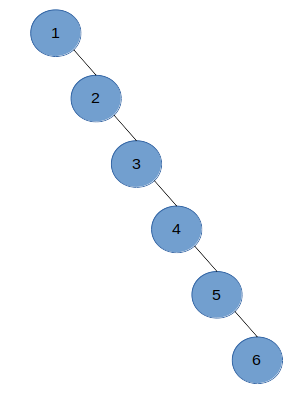 图1
图1
AVL 树是一棵具有平衡条件的二叉搜索树,它需要满足树中的每个结点的左子树和右子树的高相差不超过 1。如下图2 中不是 AVL 树,因为根结点 2 的右子树比左子树高 2。图3 中的树为 AVL 树。
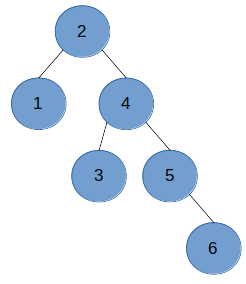 图2
图2
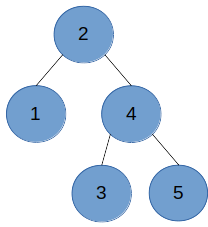 图3
图3
AVL 树实现
AVL 树结点比普通的二叉搜索树要多一个高度信息,它在每个结点中记录当前结点的高度信息,这样可以很方便的计算左右子树的高度差,也叫平衡因子,当两边高度差大于 1 时,就需要对树进行调整,以满足 AVL 树的平衡条件。
AVL 树结点定义:
#define AVLTREE_ELETYPE int
// AVL 树结点
typedef struct AVLNode {
struct AVLNode* parent; // 父结点
struct AVLNode* left; // 左结点
struct AVLNode* right; // 右结点
AVLTREE_ELETYPE data; //数据值
int height; //当前结点高度信息
}tagAVLNode;
结点计算高度的函数:
#define MAX(a, b) \
(a > b ? a : b)
static int AVLTreeHeight(tagAVLNode* node)
{
if (node == NULL)
return 0;
return MAX((node->left == NULL ? 0 : node->left->height),
(node->right == NULL ? 0 : node->right->height)) + 1;
}
创建删除 AVL 结点:
tagAVLNode* AVLTreeMallocNode(AVLTREE_ELETYPE value)
{
tagAVLNode* node = (tagAVLNode*)malloc(sizeof(tagAVLNode));
if (node == NULL)
return NULL;
node->data = value;
node->parent = NULL;
node->left = NULL;
node->right = NULL;
node->height = AVLTreeHeight(node);
return node;
}
void AVLTreeFreeNode(tagAVLNode* node)
{
free(node);
}
二叉树的旋转
左旋和右旋为 AVL 树恢复平衡条件的基本操作,我们在红黑树实现中也讲过,如下图:
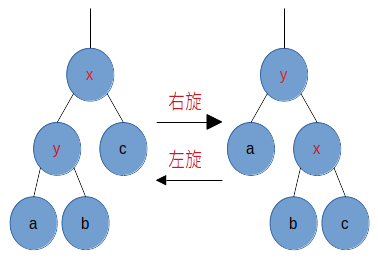
代码实现:
// 左旋
static tagAVLNode* AVLTreeLeftRotate(tagAVLNode* node)
{
if (node->right == NULL)
return node;
tagAVLNode* p = node->right;
node->right = p->left;
p->left = node;
if (node->parent != NULL) {
if (node->parent->left == node)
node->parent->left = p;
else
node->parent->right = p;
}
p->parent = node->parent;
node->parent = p;
return p;
}
// 右旋
static tagAVLNode* AVLTreeRightRotate(tagAVLNode* node)
{
if (node->left == NULL)
return node;
tagAVLNode *p = node->left;
node->left = p->right;
p->right = node;
if (node->parent != NULL) {
if (node->parent->left == node)
node->parent->left = p;
else
node->parent->right = p;
}
p->parent = node->parent;
node->parent = p;
return p;
}
左旋可以让左子树高度增加,右子树高度减少,右旋可以让左子树高度减少,右子树高度增加,我们就是利用旋转的这一特性来恢复AVL树的平衡的。
执行插入或删除操作后,AVL 树中结点恢复平衡的操作有四种:
-
当该结点的左子树比右子树高,且左结点的左子树比右子树高(不低于即可),此时只要进行一次右旋操作即可,我们记为 LLRotation,示例:
如图,当向原树中插入结点 1 时,根结点 3 左子树高为 2,右子树高为 0,结点失衡,因为结点 3 的左结点 2 的左子树比右子树高,因此只需要做一次 LLRotation。
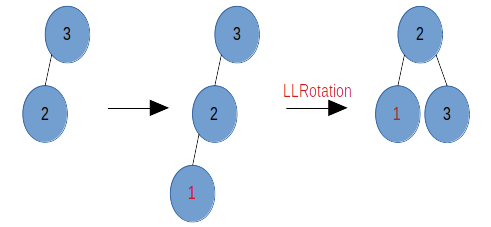
下图中,当从原树中删除结点 6 时,结点 5 的左子树高为 2,右子树高为 0,结点也失衡,因为结点 5 的左结点 3 的左子树不低于右子树,因此只需要做一次 LLRotation。
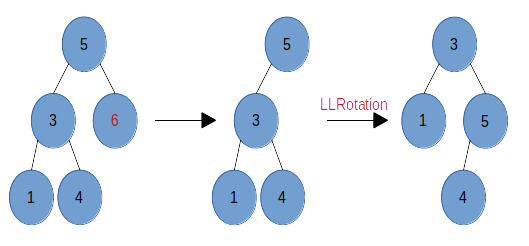
代码实现:
static tagAVLNode* AVLTreeLLRotation(tagAVLNode* node) { tagAVLNode* tmp = AVLTreeRightRotate(node); node->height = AVLTreeHeight(node); tmp->height = AVLTreeHeight(tmp); return tmp; } -
与 1 镜像操作,当该结点的右子树比左子树高,且右结点的右子树比左子树高(不低于即可),此时只需要进行一次左旋操作即可,我们记为 RRRotation,示例:
如图,当向原树中插入结点 3 时,根结点 1 左子树高为 0,右子树高为 2,结点失衡,因为结点 1 的右结点 2 的右子树比左子树高,因此只需要做一次 RRRotation。
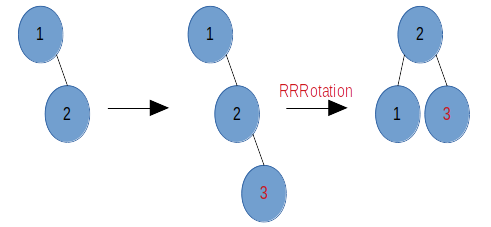
下图中,当从原树中删除结点 3 时,结点 5 的左子树高为 0,右子树高为 2,结点也失衡,因为结点 5 的右结点 7 的右子树不低于左子树,因此只需要做一次 RRRotation。
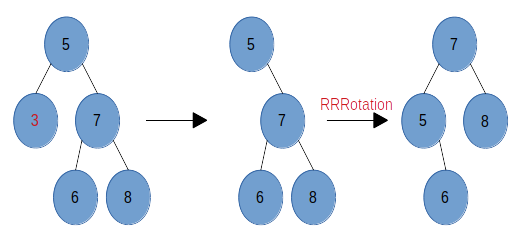
代码实现:
static tagAVLNode* AVLTreeRRRotation(tagAVLNode* node) { tagAVLNode* tmp = AVLTreeLeftRotate(node); node->height = AVLTreeHeight(node); tmp->height = AVLTreeHeight(tmp); return tmp; } -
当该结点的左子树比右子树高,且左结点的右子树比左子树高,因为进行右旋时该结点的左结点的右子树会被旋转到右侧树上,所以需要两次操作,先对该结点的左结点进行一次左旋,使其左结点的左子树的高不低于右子树,然后再对该结点进行一次右旋,我们记为 LRRotation, 如图:
当在树中添加或删除结点后形成图中最左边的树形状时,此时结点 10 的左子树高为 3,右子树高为 1,高度失衡,但是因为结点 10 的左结点 6 的左子树高低于右子树,所以先对结点 10 的左结点 6 进行一次左旋(RRRotation),然后再对结点 10 进行一次右旋(LLRotation),此时结点达到平衡。
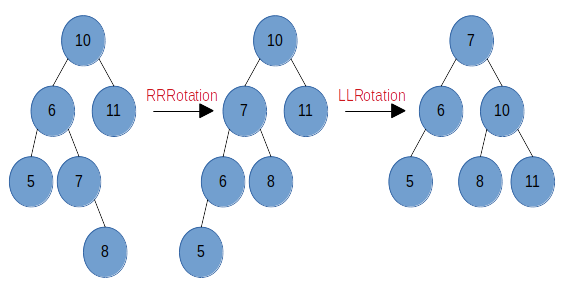
代码实现:
static tagAVLNode* AVLTreeLRRotation(tagAVLNode* node) { AVLTreeRRRotation(node->left); return AVLTreeLLRotation(node); } -
与 3 镜像操作,当该结点的右子树比左子树高,且右结点的左子树比右子树高,因为进行左旋时该结点的右结点的左子树会被旋转到左侧树上,所以也需要两次操作,先对该结点的右结点进行一次右旋,使其右结点的右子树的高不低于左子树,然后再对该结点进行一次左旋,我们记为 RLRotation,如图:
当在树中添加或删除结点后形成图中最左边的树形状时,此时结点 5 的左子树高为 1,右子树高为 3,高度失衡,但是因为结点 5 的右结点 8 的左子树高于右子树,所以先对结点 5 的右结点 8 进行一次右旋(LLRotation),然后再对结点 5 进行一次左旋(RRRotation),此时结点达到平衡。
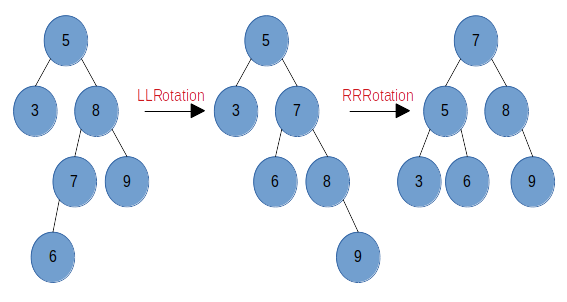
代码实现:
static tagAVLNode* AVLTreeRLRotation(tagAVLNode* node) { AVLTreeLLRotation(node->right); return AVLTreeRRRotation(node); }
AVL 树的插入
有了 AVL 树结点恢复平衡的方式,我们可以来进行 AVL 树结点的插入和删除。这里我们都用的递归的方式来求解。
插入结点时,先根据插入的值来确定插入结点的位置,创建结点并插入后从插入点向上依次判断结点是否满足平衡条件,如果不满足则根据四种旋转方式来调整:
tagAVLNode* AVLTreeInsert(tagAVLNode* root, AVLTREE_ELETYPE value)
{
if (root == NULL) {
return AVLTreeMallocNode(value);
} else if (root->data > value) {
root->left = AVLTreeInsert(root->left, value);
if (root->left != NULL)
root->left->parent = root;
root->height = AVLTreeHeight(root);
if (AVLTreeHeight(root->left) - AVLTreeHeight(root->right) > 1) {
if (root->left->data > value)
return AVLTreeLLRotation(root);
else
return AVLTreeLRRotation(root);
}
} else if (root->data < value) {
root->right = AVLTreeInsert(root->right, value);
if (root->right != NULL)
root->right->parent = root;
root->height = AVLTreeHeight(root);
if (AVLTreeHeight(root->right) - AVLTreeHeight(root->left) > 1) {
if (root->right->data > value)
return AVLTreeRLRotation(root);
else
return AVLTreeRRRotation(root);
}
} else {
printf("node has exist!\n");
}
return root;
}
AVL 树的删除
AVL 树删除结点时需要先查找到该结点,然后分几种情况来删除,当该结点为叶子结点时,直接删除该结点。当该结点只有一个孩子时,将该结点直接替换成它的孩子结点,其孩子结点必定是叶子结点,直接删除其子结点。当该结点有两个孩子时,我们用它的前驱或后继来替换它,然后删除它的前驱或后继。前驱结点可以通过查找它的左子树的最大值,后继结点可以通过查找它的右子树的最小值来实现。这里我们用后继实现。
代码实现:
tagAVLNode* AVLTreeFindMin(tagAVLNode* root)
{
if (root == NULL)
return NULL;
if (root->left != NULL)
return AVLTreeFindMin(root->left);
else
return root;
}
tagAVLNode* AVLTreeFindMax(tagAVLNode* root)
{
if (root == NULL)
return NULL;
if (root->right != NULL)
return AVLTreeFindMax(root->right);
else
return root;
}
// 删除 AVL 树结点
tagAVLNode* AVLTreeDelete(tagAVLNode* root, AVLTREE_ELETYPE value)
{
if (root == NULL)
return NULL;
else if (root->data > value) {
root->left = AVLTreeDelete(root->left, value);
} else if (root->data < value) {
root->right = AVLTreeDelete(root->right, value);
} else {
if (root->left != NULL && root->right != NULL) {
tagAVLNode* node = AVLTreeFindMin(root->right);
root->data = node->data;
root->right = AVLTreeDelete(root->right, node->data);
} else if (root->left != NULL) {
root->data = root->left->data;
root->left = AVLTreeDelete(root->left, root->left->data);
} else if (root->right != NULL) {
root->data = root->right->data;
root->right = AVLTreeDelete(root->right, root->right->data);
} else {
AVLTreeFreeNode(root);
return NULL;
}
}
root->height = AVLTreeHeight(root);
if (AVLTreeHeight(root->left) - AVLTreeHeight(root->right) > 1) {
if (AVLTreeHeight(root->left->left) >= AVLTreeHeight(root->left->right)) {
return AVLTreeLLRotation(root);
} else {
return AVLTreeLRRotation(root);
}
} else if (AVLTreeHeight(root->right) - AVLTreeHeight(root->left) > 1) {
if (AVLTreeHeight(root->right->right) >= AVLTreeHeight(root->right->left)) {
return AVLTreeRRRotation(root);
} else {
return AVLTreeRLRotation(root);
}
}
return root;
}
AVL 树的遍历
AVL 树是一棵特殊的二叉树,其遍历同二叉树的遍历相同,具体过程不再缀述,请参考二叉树的四种遍历方法
参考:
<数据结构与算法分析-C语言描述> P4